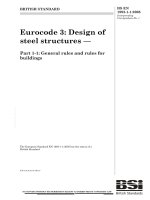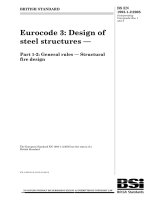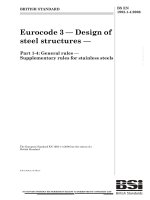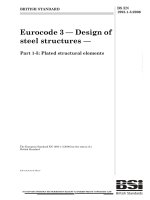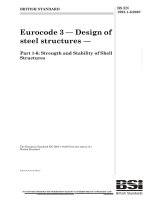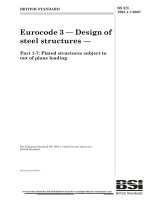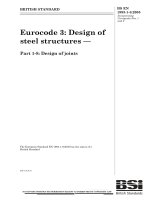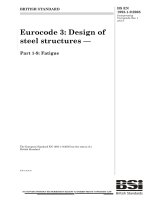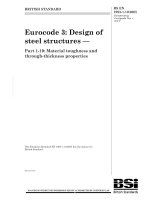Tiêu chuẩn Châu Âu EC3: Kết cấu thép phần 1.4: Thép không gỉ (Eurocode3 BS EN1993 1 4 e 2006 Design of steel structures part 1.4: Stainless steel)
Bạn đang xem bản rút gọn của tài liệu. Xem và tải ngay bản đầy đủ của tài liệu tại đây (589.78 KB, 38 trang )
BRITISH STANDARD
BS EN
1993-1-4:2006
Part 1-4: General rules —
Supplementary rules for stainless steels
The European Standard EN 1993-1-4:2006 has the status of a
British Standard
ICS 91.040.01; 91.080.10
12 &23<,1* :,7+287 %6, 3(50,66,21 (;&(37 $6 3(50,77(' %< &23<5,*+7 /$:
--```,,`,`````,,`,,``,`,,,,,`,,-`-`,,`,,`,`,,`---
Eurocode 3 — Design of
steel structures —
BS EN 1993-1-4:2006
National foreword
This British Standard was published by BSI. It is the UK implementation of
EN 1993-1-4:2006.
The UK participation in its preparation was entrusted by Technical Committee
B/525, Building and civil engineering structures, to Subcommittee B/525/31,
Structural use of steel.
--```,,`,`````,,`,,``,`,,,,,`,,-`-`,,`,,`,`,,`---
A list of organizations represented on B/525/31 can be obtained on request to
its secretary.
The structural Eurocodes are divided into packages by grouping Eurocodes for
each of the main materials: concrete, steel, composite concrete and steel,
timber, masonry and aluminium; this is to enable a common date of
withdrawal (DOW) for all the relevant parts that are needed for a particular
design. The conflicting national standards will be withdrawn at the end of the
coexistence period, after all the EN Eurocodes of a package are available.
Following publication of the EN, there is a period allowed for national
calibration during which the National Annex is issued, followed by a
coexistence period of a maximum three years. During the coexistence period
Member States are encouraged to adapt their national provisions. Conflicting
national standards will be withdrawn by March 2010 at the latest. Where a
normative part of this EN allows for a choice to be made at national level, the
range and possible choice will be given in the normative text, and a note will
qualify it as a Nationally Determined Parameter (NDP). NDPs can be a specific
value for a factor, a specific level or class, a particular method or a particular
application rule if several are proposed in the EN. To enable EN 1993-1-4 to be
used in the UK, the NDPs will be published in a National Annex, which will be
made available by BSI in due course after public consultation has taken place.
This publication does not purport to include all the necessary provisions of a
contract. Users are responsible for its correct application.
Compliance with a British Standard cannot confer immunity from
legal obligations.
This British Standard was
published under the authority
of the Standards Policy and
Strategy Committee
on 30 November 2006
© BSI 2006
ISBN 0 580 49666 X
Amendments issued since publication
Amd. No.
Date
Comments
EUROPEAN STANDARD
EN 1993-1-4
NORME EUROPÉENNE
EUROPÄISCHE NORM
October 2006
ICS 91.040.01; 91.080.10
Supersedes ENV 1993-1-4:1996
English Version
Eurocode 3 - Design of steel structures - Part 1-4: General rules
- Supplementary rules for stainless steels
Eurocode 3 - Calcul des structures en acier - Partie 1-4:
Règles générales - Règles supplémentaires pour les aciers
inoxydables
Eurocode 3 - Bemessung und Konstruktion von
Stahlbauten - Teil 1-4: Allgemeine Bemessungsregeln Ergänzende Regeln zur Anwendung von nichtrostender
Stählen
CEN members are bound to comply with the CEN/CENELEC Internal Regulations which stipulate the conditions for giving this European
Standard the status of a national standard without any alteration. Up-to-date lists and bibliographical references concerning such national
standards may be obtained on application to the Central Secretariat or to any CEN member.
This European Standard exists in three official versions (English, French, German). A version in any other language made by translation
under the responsibility of a CEN member into its own language and notified to the Central Secretariat has the same status as the official
versions.
--```,,`,`````,,`,,``,`,,,,,`,,-`-`,,`,,`,`,,`---
This European Standard was approved by CEN on 9 January 2006.
CEN members are the national standards bodies of Austria, Belgium, Cyprus, Czech Republic, Denmark, Estonia, Finland, France,
Germany, Greece, Hungary, Iceland, Ireland, Italy, Latvia, Lithuania, Luxembourg, Malta, Netherlands, Norway, Poland, Portugal, Romania,
Slovakia, Slovenia, Spain, Sweden, Switzerland and United Kingdom.
EUROPEAN COMMITTEE FOR STANDARDIZATION
COMITÉ EUROPÉEN DE NORMALISATION
EUROPÄISCHES KOMITEE FÜR NORMUNG
Management Centre: rue de Stassart, 36
© 2006 CEN
All rights of exploitation in any form and by any means reserved
worldwide for CEN national Members.
B-1050 Brussels
Ref. No. EN 1993-1-4:2006: E
EN 1993-1-4: 2006 (E)
Contents
Page
Foreword
3
1 General
4
1.1 Scope
1.2 Normative references
1.3 Assumptions
1.4 Distinction between principles and application rules
1.5 Definitions
1.6 Symbols
2 Materials
4
4
5
5
5
5
6
2.1 Structural stainless steels
2.2 Bolts
2.3 Welding consumables
3 Durability
6
8
9
9
4 Serviceability limit states
4.1 General
4.2 Determination of deflections
5 Ultimate limit states
10
10
10
12
5.1 General
5.2 Classification of cross-sections
5.3 Resistance of cross-sections
5.4 Buckling resistance of members
5.5 Uniform members in bending and axial compression
5.6 Shear resistance
5.7 Transverse web stiffeners
6 Connection design
12
12
17
18
20
21
21
22
6.1 General
6.2 Bolted connections
6.3 Design of welds
22
22
23
7 Design assisted by testing
23
8 Fatigue
23
9 Fire resistance
23
Annex A [informative] Durability
24
A.1 Introduction
A.2 Types of corrosion
A.3 Levels of risk
A.4 Selection of materials
A.5 Design for corrosion control
A.6 Connections
Annex B [informative] Stainless steel in the work hardened condition
B.1 General
B.2 Work hardening from cold rolling
B.3 Work hardening from fabrication
Annex C [informative] Modelling of material behaviour
C.1 General
C.2 Material properties
--```,,`,`````,,`,,``,`,,,,,`,,-`-`,,`,,`,`,,`---
2
24
25
27
27
30
31
34
34
34
34
35
35
35
EN 1993-1-4: 2006 (E)
Foreword
This European Standard EN 1993-1-4, Eurocode 3: Design of steel structures: Part 1-4 General Rules –
Supplementary rules for stainless steels, has been prepared by Technical Committee CEN/TC250 « Structural
Eurocodes », the Secretariat of which is held by BSI. CEN/TC250 is responsible for all Structural Eurocodes.
This European Standard shall be given the status of a National Standard, either by publication of an identical
text or by endorsement, at the latest by April 2007 and conflicting National Standards shall be withdrawn
at latest by March 2010.
This Eurocode supersedes ENV 1993-1-4.
According to the CEN-CENELEC Internal Regulations, the National Standard Organizations of the
following countries are bound to implement this European Standard: Austria, Belgium, Cyprus, Czech
Republic, Denmark, Estonia, Finland, France, Germany, Greece, Hungary, Iceland, Ireland, Italy, Latvia,
Lithuania, Luxembourg, Malta, Netherlands, Norway, Poland, Portugal, Romania, Slovakia, Slovenia, Spain,
Sweden, Switzerland and United Kingdom.
National Annex for EN 1993-1-4
This standard gives alternative procedures, values and recommendations with notes indicating where national
choices may have to be made. The National Standard implementing EN 1993-1-4 should have a National
Annex containing all Nationally Determined Parameters to be used for the design of steel structures to be
constructed in the relevant country.
–
2.1.4(2)
–
2.1.5(1)
–
5.1(2)
–
5.5(1)
–
5.6(2)
–
6.1(2)
–
6.2(3)
--```,,`,`````,,`,,``,`,,,,,`,,-`-`,,`,,`,`,,`---
National choice is allowed in EN 1993-1-4 through clauses:
3
EN 1993-1-4: 2006 (E)
1 General
1.1 Scope
(1) This Part 1.4 of EN 1993 gives supplementary provisions for the design of buildings and civil
engineering works that extend and modify the application of EN 1993-1-1, EN 1993-1-3, EN 1993-1-5 and EN
1993-1-8 to austenitic, austenitic-ferritic and ferritic stainless steels.
NOTE 1:
Information on the durability of stainless steels is given in Annex A.
NOTE 2:
The execution of stainless steel structures is covered in EN 1090.
NOTE 3:
Guidelines for further treatment, including heat treatment, are given in EN 10088.
1.2 Normative references
This following normative documents contain provisions which, through reference to this text, constitute
provisions of this European Standard. For dated references, subsequent amendments to or revisions of any of
these publications do not apply. However, parties to agreements based on this European Standard are
encouraged to investigate the possibility of applying the most recent editions of the normative documents
indicated below. For undated references, the latest edition of the normative document referred to applies.
EN 1990
Eurocode 0: Basis of structural design
EN 508-3
Roofing products from metal sheet. Specification for self-supporting products of steel,
aluminium or stainless steel sheet. Stainless steel;
EN 1090-2
Execution of steel structures and aluminium structures – Part 2: Technical requirements
for steel structures;
EN 1993-1-1
Design of steel structures: General rules and rules for buildings;
EN 1993-1-2
Design of steel structures: Structural fire design;
EN 1993-1-3
Design of steel structures: Cold formed thin gauge members and sheeting;
EN 1993-1-5
Design of steel structures: Plated structural elements;
EN 1993-1-6
Design of steel structures: Strength and stability of shell structures;
EN 1993-1-8
Design of steel structures: Design of joints;
EN 1993-1-9
Design of steel structures: Fatigue;
EN 1993-1-10
Design of steel structures: Material toughness and through-thickness properties;
EN 1993-1-11
Design of steel structures: Design of structures with tension components made of steel;
EN 1993-1-12
Design of steel structures: Additional rules for the extension of EN 1993 up to steel grades
S 700;
EN ISO 3506-1
Mechanical properties of corrosion resistant stainless steel fasteners – Part 1: Bolts,
screws and studs;
EN ISO 3506-2
Mechanical properties of corrosion resistant stainless steel fasteners – Part 2: Nuts
EN ISO 3506-3
Mechanical properties of corrosion resistant stainless steel fasteners – Part 3: Set screws
and similar fasteners under tensile tests;
EN ISO 7089
Plain washers - Normal series - Product grade A;
EN ISO 7090
Plain washers, chamfered - Normal series - Product grade A;
EN ISO 9445
Continuously cold-rolled stainless steel narrow strip, wide strip, plate/sheet and cut lengths
- Tolerances on dimensions and form
EN 10029
Specification for tolerances on dimensions, shape and mass for hot rolled steel plates
3 mm thick or above;
4
--```,,`,`````,,`,,``,`,,,,,`,,-`-`,,`,,`,`,,`---
EN 1993-1-4: 2006 (E)
EN 10052
Vocabulary of heat treatment terms for ferrous products;
EN 10088-1
Stainless steels – Part 1: List of stainless steels;
EN 10088-2
Stainless steels – Part 2: Technical delivery conditions for sheet/plate and strip for
general purposes;
EN 10088-3
Stainless steels - Part 3: Technical delivery conditions for semi-finished products, bars,
rods and sections for general purposes;
EN 10162
Cold rolled steel sections. Technical delivery conditions. Dimensional and cross-sectional
tolerances;
EN 10219-2
Cold formed welded structural sections of non-alloy and fine grain steels. Tolerances,
dimensions and sectional properties;
1.3 Assumptions
(1)
In addition to the general assumptions of EN 1990 the following assumptions apply:
--```,,`,`````,,`,,``,`,,,,,`,,-`-`,,`,,`,`,,`---
- fabrication and erection complies with EN 1090-2.
1.4 Distinction between principles and application rules
(1) The rules in EN 1990 clause 1.4 apply.
1.5 Definitions
(1)
The rules in EN 1990 clause 1.5 apply.
(2)
Unless otherwise stated, the vocabulary of treatment terms for ferrous products used in EN 10052
applies.
1.6 Symbols
In addition to those given in EN 1990, EN 1993-1-1, EN 1993-1-3, EN 1993-1-5 and 1993-1-8, the following
symbols are used:
fu,red
Es,ser
Es,1
Es,2
σ1,Ed,ser
n
reduced value of bearing strength
secant modulus of elasticity used for serviceability limit state calculations
secant modulus corresponding to the stress in the tension flange
secant modulus corresponding to the stress in the compression flange
serviceability design stress
coefficient
5
EN 1993-1-4: 2006 (E)
2 Materials
2.1 Structural stainless steels
2.1.1
General
(1) The provisions given in this Part 1.4 should be applied only to design using austenitic, austenitic-ferritic
and ferritic stainless steels.
(2) The nominal values of the material properties given in 2.1.2 should be used as characteristic values in
structural design calculations.
(3)
For further information about material properties reference should be made to EN 10088.
(4) The design provisions specified in this Part 1.4 are applicable for material of nominal yield strength fy
up to and including 480 N/mm2.
NOTE: Rules for the use of work hardened material with fy > 480 N/mm2 are given in Informative
Annex B.
(5) The higher strength of other materials (see 2.1.2 and Annex B) may be taken into account in the design
provided that doing so is justified by appropriate tests in accordance with Section 7.
2.1.2
Material properties for stainless steel
(1)
In design calculations the values should be taken as follows, independent of the direction of rolling:
-
yield strength fy: the nominal stress (0,2% proof stress) specified in Table 2.1;
-
ultimate tensile strength fu: the nominal ultimate tensile strength specified in Table 2.1.
(2) The ductility requirements in EN 1993-1-1, clause 3.2.2 also apply to stainless steels. Steels conforming
with one of the steel grades listed in Table 2.1 should be accepted as satisfying these requirements.
(3) For structural hollow sections, the strength values given in Table 2.1 for the relevant product form of the
base material (cold-rolled strip, hot rolled strip or hot rolled plate) should be used.
(4) Higher strength values derived from cold working the base material may be used in design provided they
are verified by tests on coupons taken from the structural hollow section in accordance with Section 7.
--```,,`,`````,,`,,``,`,,,,,`,,-`-`,,`,,`,`,,`---
(5) For cold worked material, the material tests given in the material certificate required according to EN
1090, should be in such a direction that the strength values used in design are independent of the direction of
rolling or stretching.
6
EN 1993-1-4: 2006 (E)
Table 2.1: Nominal values of the yield strength fy and the ultimate tensile strength
fu for structural stainless steels to EN 10088 1)
Product form
Type of
stainless
steel
Ferritic
steels
Austenitic
steels
Cold rolled strip
Grade
t ≤ 6 mm
1.4003
1.4016
1.4512
1.4306
1.4307
1.4541
1.4301
1.4401
1.4404
1.4539
1.4571
1.4432
1.4435
1.4311
1.4406
1.4439
1.4529
1.4547
1.4318
1.4362
Hot rolled strip
Hot rolled plate
Nominal thickness t
t ≤ 12 mm
t ≤ 75 mm
fy
fu
fy
fu
2
2
2
N/mm
N/mm
N/mm
N/mm2
280
450
2503)
4503)
3)
240
450
240
4303)
210
380
-
fy
N/mm2
280
260
210
fu
N/mm2
450
450
380
220
520
200
520
200
500
230
540
210
520
210
520
220
520
240
530
220
540
530
550
220
550
220
520
290
300
290
300
320
350
420
550
270
280
270
300
300
330
400
550
270
280
270
300
300
330
400
550
650
650
650
600
t ≤ 250 mm
fy
fu
2
N/mm
N/mm2
2604)
4504)
4)
240
4004)
180
460
175
450
190
500
200
500
230
530
200
500
270
550
280
580
300
400 2)
650
600 2)
540
240
580
Bars, rods and
sections
580
650
650
650
600
580
650
650
630
630
Austenitic
-ferritic
1.4462
480
660
460
660
460
640
450
650
steels
1)
The nominal values of fy and fu given in this table may be used in design without taking special account of
anisotropy or strain hardening effects.
2)
t ≤ 160 mm
3)
t ≤ 25 mm
4)
t ≤ 100 mm
Design values of material coefficients
(1) The following values of the material coefficients may be assumed for the global analysis and in
determining the resistances of members and cross-sections:
-
Modulus of elasticity, E:
E
= 200 000 N/mm2 for the austenitic and austenitic-ferritic grades in Table 2.1 excluding grades
1.4539, 1.4529 and 1.4547
E
= 195 000 N/mm2 for the austenitic grades 1.4539, 1.4529 and 1.4547
E
= 220 000 N/mm2 for the ferritic grades in Table 2.1
E
2 (1 + ν )
-
Shear modulus, G, where G =
-
Poisson’s ratio in elastic stage, ν = 0,3
7
--```,,`,`````,,`,,``,`,,,,,`,,-`-`,,`,,`,`,,`---
2.1.3
EN 1993-1-4: 2006 (E)
Alternatively, stress-strain curves according to Annex C may be used for materials in the annealed condition to
describe the material behaviour.
(2) For calculating deflections in individual members, the secant modulus appropriate to the stress in the
member at the serviceability limit state may be used, see 4.2(5).
2.1.4
Fracture toughness
(1) The austenitic and austenitic-ferritic stainless steels covered in this Part 1.4 may be assumed to be
adequately tough and not susceptible to brittle fracture for service temperatures down to -40°C.
NOTE: Austenitic steels may also be used for temperatures below -40°C, but the requirements should be
determined for each particular case.
NOTE: See Annex A.5.3 concerning embrittlement due to contact with zinc in fire.
(2) For ferritic stainless steels, the rules in EN 1993-1-10 give guidance. Required testing temperature and
required CVN-values may be determined from Table 2.1 of EN 1993-1-10.
NOTE 1: Ferritic steels are not classified into sub-grades.
NOTE 2: The National Annex may provide further information on fracture toughness of ferritic stainless steels.
2.1.5
(1)
Through-thickness properties
Guidance on the choice of through-thickness properties is given in EN 1993-1-10.
NOTE: The National Annex may provide further information on the choice of through thickness properties.
2.1.6
Tolerances
(1) The dimensional and mass tolerances of rolled steel sections, structural hollow sections and plates
should conform with the relevant product standard unless more severe tolerances are specified.
NOTE: For information about tolerances for thickness of cold rolled stainless steel, reference should be made to
EN ISO 9445: 2006. For plates see EN 10029
(2)
For welded components the tolerances given in EN 1090-2 should be applied.
(3) For structural analysis and design, the nominal values of dimensions should be used except that the
design thickness of strips should be determined according to 3.2.4(3) of EN 1993-1-3.
2.2 Bolts
2.2.1
General
(1) Stainless steel bolts and nuts should conform with EN ISO 3506 - 1,2,3. Washers should be of stainless
steel and should conform with EN ISO 7089 or EN ISO 7090, as appropriate. The corrosion resistance of the
bolts should be equivalent to, or better than, the corrosion resistance of the parent material.
(2) The nominal yield strength fyb and ultimate tensile strength fub for stainless steel bolts should be
obtained from Table 2.2.
(3) Pending the issue of an appropriate European Standard, the specified properties should be verified using
a recognised quality control system, with samples from each batch of fasteners.
--```,,`,`````,,`,,``,`,,,,,`,,-`-`,,`,,`,`,,`---
8
EN 1993-1-4: 2006 (E)
Table 2.2: Nominal values of fyb and fub for stainless steel bolts
Material
groups
Austenitic
and
austeniticferritic
2.2.2
Property class
to
EN ISO 3506
50
≤ M 39
Yield strength
fyb
N/mm2
210
Ultimate tensile strength
fub
N/mm2
500
70
≤ M 24
450
700
80
≤ M 24
600
800
Range of sizes
Preloaded bolts
NOTE: High strength bolts made of stainless steel should not be used as preloaded bolts designed for a specific slip
resistance, unless their acceptability in a particular application can be demonstrated from test results.
2.2.3
(1)
Other types of mechanical fastener
Requirements for other types of mechanical fasteners are given in EN 1993-1-3.
2.3 Welding consumables
(1)
General requirements for welding consumables are given in EN 1993-1-8.
(2) In addition to the requirements of EN 1993-1-8, the welding electrodes should be capable of producing a
weld with a corrosion resistance that is adequate for the service environment, provided that the correct welding
procedure is used.
(3) The welding electrodes may be assumed to be adequate if the corrosion resistance of the deposited metal
and weld metal is not less than that of the material to be welded.
NOTE: Professional advice is recommended on the selection of welding procedure for jointing stainless steels
3 Durability
(1) The requirements for durability given in Section 4 of EN 1993-1-1 should also be applied for stainless
steels.
(2) An appropriate grade of stainless steel should be selected according to the corrosion resistance required
for the environment in which the structural members are to be used.
NOTE: Guidance on the selection of materials for corrosion resistance is given in Annex A.
(3) In cosmetic applications, the possible minor changes in surface appearance that might take place as a
result of dirt deposits (which in adverse circumstances can create crevices and lead to surface micro-pitting)
should also be taken into account. A suitable corrosion-resistant grade of stainless steel should be used to
ensure that only superficial surface attack takes place within the design life of the component.
NOTE: Surface aspect features of hot rolled plates are described in EN 10163.
(4)
If necessary, a suitable cleaning regime should be specified to maintain surface appearance.
(5) Although, under benign atmospheric exposure conditions, the requirements given in (3) can be satisfied
by most stainless steels, expert advice should be sought if stainless steel is required to be exposed to
environments that contain chemicals, including atmospheres associated with certain industrial processes, in
swimming pool buildings, sea water and salt spray from road de-icing or the like.
--```,,`,`````,,`,,``,`,,,,,`,,-`-`,,`,,`,`,,`---
9
EN 1993-1-4: 2006 (E)
NOTE: Additional information on design for corrosion control is given in Annex A.
4 Serviceability limit states
4.1 General
(1) The requirements for serviceability given in Section 7 of EN 1993-1-1 should be applied for stainless
steels.
(2)
Deflections in members should be estimated in accordance with 4.2.
4.2 Determination of deflections
(1) The effects of the non-linear stress-strain behaviour of stainless steels, and the effectiveness of the crosssection, should be taken into account in estimating deflections.
NOTE: Guidance for the description of the non-linear material behaviour of annealed material is given in
Informative Annex C.
--```,,`,`````,,`,,``,`,,,,,`,,-`-`,,`,,`,`,,`---
(2)
The basic requirements for serviceability limit states are given in clause 3.4 of EN 1990.
NOTE:
-
EN 1990 gives the appropriate combinations of actions to use in the following situations:
for calculating deflections under permanent and/or variable actions;
when long term deformations due to shrinkage, relaxation or creep need to be considered;
if the appearance of the structure or the comfort of the user or functioning of machinery are being
considered.
(3) The effective cross-section may conservatively be based on effective widths of compression elements in
Class 4 cross-sections determined using 5.2.3. Alternatively, the more accurate method in 4.4(4) of EN 1993-15 may be used.
(4) In the case of members subject to shear lag, the effective cross-section may be based on effective widths
determined using 3.2 in EN 1993-1-5.
(5) Deflections should be estimated using the secant modulus of elasticity Es,ser determined taking account
of the stresses in the member under the load combination for the relevant serviceability limit state and the
orientation of the rolling direction. If the orientation of the rolling direction is not known, or cannot be ensured,
then the value for the longitudinal direction should be used. Alternatively, the FE-methods given in Annex C of
EN 1993-1-5 may be used with the description of the non-linear material behaviour given in Annex C of this
document.
(6)
The value of the secant modulus of elasticity Es,ser may be obtained from:
Es , ser =
( Es ,1 + Es , 2 )
2
(4.1)
where:
Es,1
is the secant modulus corresponding to the stress σ1 in the tension flange;
Es,2
is the secant modulus corresponding to the stress σ2 in the compression flange.
(7) The values of Es,1 and Es,2 for the appropriate serviceability design stress σi,Ed,ser and rolling direction
may be estimated using:
10
EN 1993-1-4: 2006 (E)
E
Es ,i =
1 + 0,002
E
σ i , Ed,ser
(4.2)
n
σ i, Ed,ser
f
y
with:
i
(8)
= 1 or 2.
The value of the coefficient n may be taken from Table 4.1.
NOTE: Annex C gives a method for evaluating n for grades other than those listed in Table 4.1.
(9) As a simplification, the variation of Es,ser along the length of the member may be neglected and the
minimum value of Es,ser for that member (corresponding to the maximum values of the stresses σ1,Ed,ser and
σ2,Ed,ser in the member) may be used throughout its length.
Table 4.1: Values of n
Steel grade
1.4003
1.4016
1.4512
1.4301
1.4306
1.4307
1.4318
1.4541
1.4401
1.4404
1.4432
1.4435
1.4539
1.4571
1.4462
1.4362
Longitudinal
direction
7
6
9
Transverse
direction
11
14
16
6
8
7
9
5
5
--```,,`,`````,,`,,``,`,,,,,`,,-`-`,,`,,`,`,,`---
Coefficient n
11
EN 1993-1-4: 2006 (E)
5 Ultimate limit states
5.1 General
(1) The provisions given in Sections 5 and 6 of EN 1993-1-1 should be applied for stainless steels, except
where modified or superseded by the special provisions given in this Part 1.4.
(2) The partial factors γM as defined in 2.4.3 of EN 1993-1-1 are applied to the various characteristic values
of resistance in this section as follows, see Table 5.1.
Table 5.1: Partial factors
Resistance of cross-sections to excessive yielding including
local buckling
Resistance of members to instability assessed by member
checks
Resistance of cross-sections in tension to fracture
Resistance of bolts, rivets, welds, pins and plates in bearing
γM0
γM1
γM2
γM2
NOTE: γM values may be determined in the National Annex. The following values are recommended
γM0 = 1,1
γM1 = 1,1
γM2 = 1,25
(3)
No rules are given for plastic global analysis.
NOTE: Plastic global analysis should not be used unless there is sufficient experimental evidence to ensure that
the assumptions made in the calculations are representative of the actual behaviour of the structure. In particular
there should be evidence that the joints are capable of resisting the increase in internal moments and forces due to
strain hardening.
(4)P Joints subject to fatigue shall also satisfy the principles given in EN 1993-1-9.
(5) Where members may be subjected to significant deformation, account may be taken of the potential for
enhanced strength gained through the work hardening properties of austenitic stainless steel. Where this work
hardening increases the actions resisted by the members, the joints should be designed to be consistent with the
increased member resistance, especially where capacity design is required.
5.2 Classification of cross-sections
5.2.1
Maximum width-to-thickness ratios
(1) The provisions for design by calculation given in this Part 1.4 may be assumed to apply to cross-sections
within the dimensional limits given in EN 1993-1-3, except that the overall width-to-thickness ratios b/t and
h/t as defined in EN 1993-1-3 should not exceed 400, see Figure 5.1.
(2) If visual distortion of flat elements of the cross-section are unacceptable under the serviceability loading,
a limit of b/t ≤ 75 may be applied.
12
--```,,`,`````,,`,,``,`,,,,,`,,-`-`,,`,,`,`,,`---
EN 1993-1-4: 2006 (E)
Figure 5.1: Maximum width-to-thickness ratios
5.2.2
Classification of compression elements
(1) Compression elements of cross-sections should be classified as Class 1, 2 or 3 depending upon the limits
specified in Table 5.2. Those compression elements that do not meet the criteria for Class 3 should be
classified as Class 4 elements.
--```,,`,`````,,`,,``,`,,,,,`,,-`-`,,`,,`,`,,`---
13
EN 1993-1-4: 2006 (E)
Table 5.2 (sheet 1 of 3): Maximum width-to-thickness ratios for compression parts
Internal compression parts
h
c
t
c
c
t
t
t
t
c
Axis of bending
t
c
c
Axis of bending
Class
Stress
distribution
in parts
(compression
positive)
Part subject to
bending
fy
Part subject to
compression
fy
+
+
fy
+
c
αc
c
fy
Part subject to bending and compression
fy
-
fy
when α > 0,5 : c / t ≤
--```,,`,`````,,`,,``,`,,,,,`,,-`-`,,`,,`,`,,`---
c / t ≤ 56,0ε
1
c / t ≤ 25,7ε
when α ≤ 0,5 : c / t ≤
when α > 0,5 : c / t ≤
c / t ≤ 58,2ε
2
c / t ≤ 26,7ε
when α ≤ 0,5 : c / t ≤
fy
Stress
distribution
in parts
(compression
positive)
fy
c/2
+
c
α
c
-
c / t ≤ 74,8ε
0,5
c / t ≤ 30,7ε
Grade
fy (N/mm2)
ε
1.4301
210
1,03
Note: For hollow sections, c may conservatively be taken as (h-2t) or (b-2t).
14
320ε
13α − 1
29,1ε
ψ fy
fy
235
E
ε =
f y 210 000
α
+
c
3
308ε
13α − 1
28ε
fy
+
-
c
-
c / t ≤ 15,3ε kσ
For kσ see EN 1993-1-5
1.4401
220
1,01
1.4462
460
0,698
EN 1993-1-4: 2006 (E)
Table 5.2 (sheet 2 of 3): Maximum width-to-thickness ratios for compression parts
Outstand flanges
c
t
c
t
Class
Section
type
fy
Stress
distribution in
parts
(compression
positive)
Part subject to bending and compression
Tip in compression
Tip in tension
Part subject to
compression
c
αc
αc
+
fy
+
–
–
fy
fy
c
Cold
formed
c / t ≤ 10ε
c/t ≤
Welded
c / t ≤ 9ε
c/t ≤
Cold
formed
c / t ≤ 10,4ε
c/t ≤
Welded
c / t ≤ 9,4ε
c/t ≤
c
10ε
c/t ≤
α
10ε
α α
1
9ε
c/t ≤
α
10,4ε
c/t ≤
α
9ε
α α
10,4ε
α α
2
fy
--```,,`,`````,,`,,``,`,,,,,`,,-`-`,,`,,`,`,,`---
Stress
distribution in
parts
(compression
positive)
c
9,4ε
c/t ≤
α
fy
+
–
+
–
+
–
fy
9,4ε
α α
fy
c
+
–
c
Cold
formed
c / t ≤ 11,9ε
c / t ≤ 18,1ε kσ
For kσ see EN 1993-1-5
Welded
c / t ≤ 11ε
c / t ≤ 16,7ε kσ
For kσ see EN 1993-1-5
3
235
E
ε =
f y 210 000
0,5
Grade
fy (N/mm2)
ε
1.4301
210
1,03
1.4401
220
1,01
1.4462
460
0,698
15
EN 1993-1-4: 2006 (E)
Table 5.2 (sheet 3 of 3): Maximum width-to-thickness ratios for compression parts
Angles
h
Refer also to “Outstand flanges”
(see sheet 2 of 3)
h
t
b
t
Does not apply to angles in
continuous contact with other
components
b
Section in compression
Class
+
Stress
distribution
across
section
(compression
positive)
fy
+
h / t ≤ 11,9ε :
3
b+h
≤ 9,1ε
2t
Tubular sections
d
t
Class
Section in bending
Up to 240 CHS
Section in compression
1
d / t ≤ 50ε 2
d / t ≤ 50ε 2
2
d / t ≤ 70ε 2
d / t ≤ 70ε 2
3
d / t ≤ 280ε 2
2
NOTE: For d > 240 mm and d / t > 280ε
see EN 1993-1-6.
0,5
Grade
fy (N/mm2)
ε
1.4301
210
1,03
1.4401
220
1,01
1.4462
460
0,698
--```,,`,`````,,`,,``,`,,,,,`,,-`-`,,`,,`,`,,`---
235
E
ε =
f y 210 000
d / t ≤ 90ε 2
2
NOTE: For d / t > 90ε see EN 1993-1-6.
16
EN 1993-1-4: 2006 (E)
5.2.3
Effective widths in Class 4 cross-sections
(1) In Class 4 cross-sections effective widths may be used to make necessary allowances for reductions in
resistance due to the effects of local buckling using 4.4(1) to (5) of EN 1993-1-5, except that the reduction
factor ρ should be taken as follows:
Cold formed or welded internal elements:
ρ=
0,772
λp
−
0,125
2
λp
but ≤ 1
(5.1)
Cold formed outstand elements:
ρ=
1
λp
−
0,231
2
λp
but ≤ 1
(5.2)
Welded outstand elements:
ρ=
1
λp
−
0,242
λ
2
p
but ≤ 1
(5.3)
where λ p is the element slenderness defined as:
λp =
b/t
28,4ε kσ
in which
t
is the relevant thickness
kσ
is the buckling factor corresponding to the stress ratio ψ and boundary conditions from Table 4.1 or
Table 4.2 in EN 1993-1-5 as appropriate
b
is the relevant width as follows:
ε
5.2.4
(1)
b
= d for webs (except RHS)
b
= flat element width for webs of RHS, which can conservatively be taken as h-2t
b
= b for internal flange elements (except RHS)
b
= flat element width for RHS flanges, which can conservatively be taken as b-2t
b
= c for outstand flanges
b
= h for equal leg angles and unequal leg angles
is the material factor defined in Table 5.2.
Effects of shear lag
The effects of shear lag should be taken into account as specified in 3.3 of EN 1993-1-5.
5.3 Resistance of cross-sections
5.3.1
Tension resistance at holes for bolts
(1) The tension resistance of a cross-section should be taken as the lesser of the plastic resistance of the
gross cross-section Npl,Rd and the ultimate resistance Nu,Rd of the net cross-section.
--```,,`,`````,,`,,``,`,,,,,`,,-`-`,,`,,`,`,,`---
17
EN 1993-1-4: 2006 (E)
(2)
The plastic resistance of the gross cross-section should be determined using:
= A fy / γM0
Npl,Rd
(3)
(5.4)
The ultimate resistance of the net cross-section should be determined from:
= kr Anet fu / γM2
Nu,Rd
(5.5)
with:
kr
= ( 1 + 3 r ( do / u - 0,3 ) )
r
= [number of bolts at the cross-section] / [total number of bolts in the connection]
u
= 2 e2
but
but kr ≤1
u ≤ p2
where:
Anet
is the net cross-sectional area;
do
is the nominal diameter of the bolt hole;
e2
is the edge distance from the centre of the bolt hole to the adjacent edge, in the direction
perpendicular to the direction of load transfer;
p2
is the spacing centre-to-centre of bolt holes, in the direction perpendicular to the direction of
load transfer.
5.4 Buckling resistance of members
5.4.1
General
(1) The provisions for flexural, lateral-torsional, torsional, flexural-torsional and distortional buckling given
in EN 1993-1-1 and EN 1993-1-3 as appropriate should be applied for stainless steels except as supplemented
or modified in 5.4.2 or 5.4.3.
NOTE:
Clause 6.3.2.3 of EN 1993-1-1 is not applicable to stainless steel.
--```,,`,`````,,`,,``,`,,,,,`,,-`-`,,`,,`,`,,`---
(2) The actions should be placed into the formulae in EN 1993-1-1 as absolute values. χmin is the lowest of
the values χy, χz, χT and χTF where χy and χz are calculated on the basis of flexural buckling, χT is calculated on
the basis of torsional buckling and χTF is calculated on the basis of torsional-flexural buckling.
5.4.2
Uniform members in compression
5.4.2.1
(1)
Buckling curves
For axial compression in members the value of χ for the appropriate non-dimensional slenderness λ
should be determined from the relevant buckling curve according to:
χ=
with
φ + [φ 2 − λ 2 ]
0, 5
≤ 1
φ = 0,5 (1 + α (λ − λ0 ) + λ 2 )
where λ =
λ=
18
1
Af y
N cr
Aeff f y
N cr
(5.6)
(5.7)
for Class 1, 2 and 3 cross-sections
(5.8)
for Class 4 cross-sections
(5.9)
EN 1993-1-4: 2006 (E)
α
is an imperfection factor
Ncr
is the elastic critical force for the relevant buckling mode based on the gross cross sectional
properties.
λ0
limiting slenderness
(2) Values for α and λ0 corresponding to the appropriate buckling curve should be obtained from Table
5.3. The buckling curves in Table 5.3 do not apply to hollow sections which are annealed after fabrication.
(3)
For slenderness λ ≤ λ 0 or for
2
N Ed
≤ λ 0 the buckling effects may be ignored and only cross
N cr
sectional checks apply.
Table 5.3: Values of α and λ0 for flexural, torsional and torsional-flexural buckling
Buckling mode
Type of member
α
λ0
Flexural
Cold formed open sections
0,49
0,40
Hollow sections (welded and seamless)
0,49
0,40
Welded open sections (major axis)
0,49
0,20
Welded open sections (minor axis)
0,76
0,20
All members
0,34
0,20
Torsional and
torsional-flexural
5.4.3
Uniform members in bending
5.4.3.1
(1)
Lateral torsional buckling curves
For bending members of constant cross-section, the value of χLT for the appropriate non-dimensional
slenderness λ LT should be determined from:
χ LT
=
1
φ LT + φ LT 2 − λ LT 2
≤
1
(5.10)
in which
(
φ LT
= 0,5 1 + α LT (λ LT − 0,4 ) + λ LT
λ LT
=
αLT
is the imperfection factor
2
)
Wy f y
(5.11)
(5.12)
M cr
= 0,34 for cold formed sections and hollow sections (welded and seamless)
= 0,76 for welded open sections and other sections for which no test data is available
Mcr
(2)
is the elastic critical moment for lateral-torsional buckling
For slendernesses λ LT ≤ 0,4 or for
M Ed
≤ 0,16 lateral torsional buckling effects may be ignored
M cr
and only cross sectional checks apply.
--```,,`,`````,,`,,``,`,,,,,`,,-`-`,,`,,`,`,,`---
19
EN 1993-1-4: 2006 (E)
5.5
(1)
Uniform members in bending and axial compression
Members which are subjected to combined bending and axial compression should satisfy:
Axial compression and uniaxial major axis moment
To prevent premature buckling about the major axis:
M y,Ed + N Ed e Ny
N Ed
≤1
+ ky
β W f /γ
( N b,Rd ) min
W, y pl, y y M1
(5.13)
To prevent premature buckling about the minor axis (for members subject to lateral-torsional buckling):
M y,Ed + N Ed e Ny
N Ed
+ k LT
( N b, Rd ) min 1
M b, Rd
≤1
(5.14)
Axial compression and uniaxial minor axis moment:
To prevent premature buckling about the minor axis:
M z,Ed + N Ed e Nz
N Ed
≤1
+ kz
β W f /γ
( N b,Rd ) min
W,z pl, z y M1
(5.15)
Axial compression and biaxial moments:
All members should satisfy:
M y,Ed + N Ed e Ny
M z,Ed + N Ed e Nz
N Ed
+ kz
≤1
+ ky
β W f /γ
β W f /γ
( N b,Rd ) min
W, y pl, y y M1
W,z pl,z y M1
(5.16)
Members potentially subject to lateral-torsional buckling should also satisfy:
M y,Ed + N Ed e Ny
N Ed
+ k LT
( N b,Rd ) min 1
M b, Rd
M z,Ed + N Ed e Nz
≤1
+ kz
β W f /γ
W,
z
pl,
z
y
M1
(5.17)
In the above expressions:
eNy and eNz are are the shifts in the neutral axes when the cross-section is subject to uniform compression
NEd, My,Ed and Mz,Ed are the design values of the compression force and the maximum moments about the
y-y and z-z axis along the member, respectively
(Nb,Rd)min is the smallest value of Nb,Rd for the following four buckling modes: flexural buckling about the
y axis, flexural buckling about the z axis, torsional buckling and torsional-flexural buckling
(Nb,Rd)min1 is the smallest value of Nb,Rd for the following three buckling modes: flexural buckling about
the z axis, torsional buckling and torsional-flexural buckling
βW,y and βW,z are the values of βW determined for the y and z axes respectively in which
20
βW
= 1,0 for Class 1 or 2 cross-sections
βW
= Wel/Wpl for Class 3 cross-sections
βW
= Weff/Wpl for Class 4 cross-sections
--```,,`,`````,,`,,``,`,,,,,`,,-`-`,,`,,`,`,,`---
EN 1993-1-4: 2006 (E)
Wpl,y and Wpl,z are the plastic moduli for the y and z axes respectively
Mb,Rd is the lateral-torsional buckling resistance
ky, kz, kLT are the interaction factors
NOTE 1: The National Annex may define ky, kz, kLT. The following values are recommended:
(
k y = 1,0 + 2 λ y − 0,5
) NN
Ed
but
1,2 ≤ k y ≤ 1,2 + 2
N Ed
N b, Rd , y
but
1,2 ≤ k z ≤ 1,2 + 2
N Ed
b , Rd , y
(
k z = 1,0 + 2 λ z − 0,5
) (N N )
Ed
b , Rd min 1
(N )
b , Rd min 1
kLT=1,0
NOTE 2: The National Annex may give other interaction formulae as alternatives to equations 5.13 to 5.17.
5.6 Shear resistance
(1) The design shear resistance Vc,Rd should be taken as the lesser of the shear buckling resistance Vb,Rd
according to 5.2(1) of EN 1993-1-5 modified by (3) and (4) and the plastic shear resistance Vpl,Rd according to
6.2.6(2) of EN 1993-1-1.
(2)
Plates with hw/t greater than
52
η
ε for an unstiffened web or
23
η
ε kτ for a stiffened web should be
checked for resistance to shear buckling and should be provided with transverse stiffeners at the supports.
is the clear web depth between flanges, see Figure 5.1 of EN 1993-1-5
where hw
ε
is defined in Table 5.2
kτ
is defined in clause 5.3 of EN 1993-1-5
The National Annex may define η. The value η = 1,20 is recommended.
NOTE:
--```,,`,`````,,`,,``,`,,,,,`,,-`-`,,`,,`,`,,`---
(3) For webs with transverse stiffeners at supports only and for webs with either intermediate transverse or
longitudinal stiffeners or both, the factor χw for the contribution of the web to shear buckling resistance
should be obtained as follows:
χw
=η
χw
= 0,11 +
where λw
(4)
for λw
0,64
λw
−
0,05
λw
2
for λw
>
≤
0,6
(5.18)
η
0,6
η
(5.19)
is given in clauses 5.3(3) and (5) of EN 1993-1-5
If the flange resistance is not fully utilised in withstanding the bending moment, i.e. M Ed < M f ,Rd ,
then a factor χf representing the contribution from the flanges may be included in the shear buckling
resistance. χf is given in clause 5.4(1) of EN 1993-1-5 but with c given below:
3,5 bf tf2 f yf
c = 0,17 +
a
t w hw2 f yw
and
c
≤ 0,65
a
(5.20)
5.7 Transverse web stiffeners
21
EN 1993-1-4: 2006 (E)
(1)
The provisions in 9.3 of EN 1993-1-5 apply with additions according to (2) and (3).
(2) The out-of-plane buckling resistance Nb,Rd of the stiffener should be determined from 5.4.2 using
α = 0,49 and λ0 = 0,2. The buckling length l of the stiffener should be appropriate for the conditions of
restraint, but not less than 0,75hw, where both ends are fixed laterally. A larger value of l should be used for
conditions that provide less end restraint. If the stiffener has a cut-out at the loaded end, its cross sectional
resistance should be checked at the loaded end considering the net area.
(3) For the buckling check, the effective cross-sectional area of a stiffener should include the stiffener itself
plus a width of web of 11 ε tw either side of the stiffener. At the ends of the member (or openings in the web) the
contributory width to be taken into account should be either 11 ε tw or the existing width, whichever is the
smaller.
6 Connection design
6.1 General
(1) The provisions given in EN 1993-1-8 should be applied for stainless steels, except where modified or
superseded by the special provisions given in 6.2 and 6.3.
NOTE: Information on durability is given in Annex A. Information on fabrication of connections is given in EN
1090-2.
(2) The design of connections for stainless steel sheets using self-tapping screws should be in accordance
with EN 1993-1-3 except that the pull-out strength should be determined by testing.
NOTE 1: The ability of the screw to drill and form threads in stainless steel should be demonstrated by tests
unless sufficient experience is available.
NOTE 2: Formulae for pull-out strength based on testing according to Section 7 may be given in the National
Annex.
6.2 Bolted connections
(1)
Bearing strength should be calculated by replacing fu by a reduced value fu,red given by:
= 0,5 fy + 0,6 fu
fu,red
but ≤ fu
(6.1)
--```,,`,`````,,`,,``,`,,,,,`,,-`-`,,`,,`,`,,`---
(2
Stainless steel bolts in shear to EN ISO 3506 property classes 50, 70 and 80 should be treated like bolts
grades 4.6, 5.6 and 8.8.
(3)
The shear resistance of a bolt, Fv,Rd should be determined from the following:
Fv , Rd =
α f ub A
γ M2
(6.2)
where
A
is the gross cross-section area of the bolt (if the shear plane passes through unthreaded
portion of the bolt); or the tensile stress area of the bolt (if the shear plane passes through the
threaded portion of the bolt);
fub
is the ultimate tensile strength of the bolt, see Table 2.2.
NOTE: The value of α may be defined in the National Annex. The recommended values are:
- if the shear plane passes through unthreaded portion of the bolt, α = 0,6
- if the shear plane passes through the threaded portion of the bolt, α = 0,5
22
EN 1993-1-4: 2006 (E)
6.3 Design of welds
(1) In determining the design resistance of fillet welds, the value of the correlation factor βW should be
taken as 1,0 for all nominal strength classes of stainless steel, unless a lower value is justified by tests in
accordance with Section 7.
7 Design assisted by testing
(1) Section 5.2 and Annex D of EN 1990 and Section 9 and Annex A of EN 1993-1-3 are applicable to
stainless steels.
--```,,`,`````,,`,,``,`,,,,,`,,-`-`,,`,,`,`,,`---
(2) Prototypes for testing should be produced in a similar manner to the components of the final product,
such that they reflect the same levels of work hardening.
(3) Because stainless steel grades can exhibit anisotropy, the specimens should be prepared from the plate or
sheet in the same orientation (i.e. transverse or parallel to the rolling direction) as intended for the final
structure. If the final orientation is unknown or cannot be guaranteed, tests should be conducted for both
orientations and the less favourable result should be adopted.
8 Fatigue
(1) For determining the fatigue strength of stainless steel structures, reference should be made to
EN 1993-1-9.
9 Fire resistance
(1) For structural fire design, material properties at elevated temperatures in Annex C of EN 1993-1-2
should be used.
23
